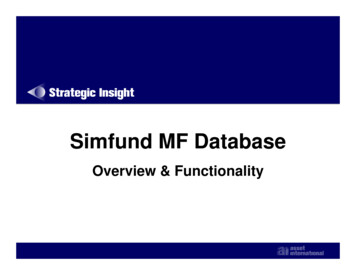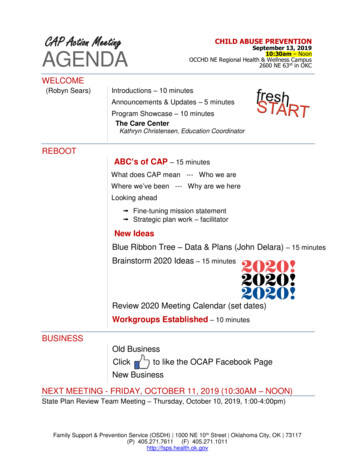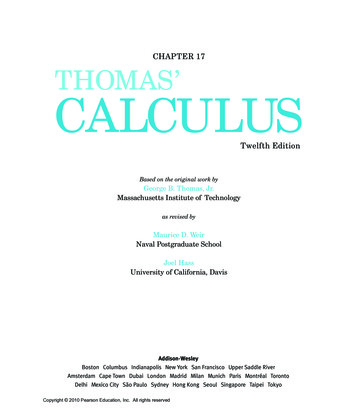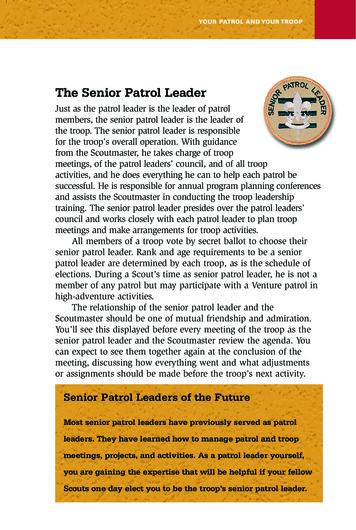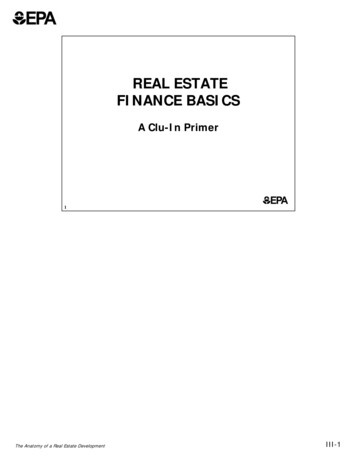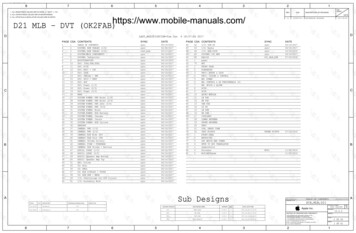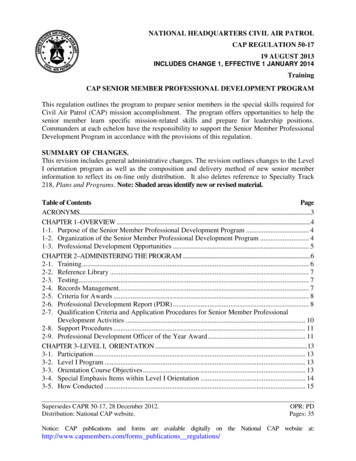
Transcription
NATIONAL HEADQUARTERS CIVIL AIR PATROLCAP REGULATION 50-1719 AUGUST 2013INCLUDES CHANGE 1, EFFECTIVE 1 JANUARY 2014TrainingCAP SENIOR MEMBER PROFESSIONAL DEVELOPMENT PROGRAMThis regulation outlines the program to prepare senior members in the special skills required forCivil Air Patrol (CAP) mission accomplishment. The program offers opportunities to help thesenior member learn specific mission-related skills and prepare for leadership positions.Commanders at each echelon have the responsibility to support the Senior Member ProfessionalDevelopment Program in accordance with the provisions of this regulation.SUMMARY OF CHANGES.This revision includes general administrative changes. The revision outlines changes to the LevelI orientation program as well as the composition and delivery method of new senior memberinformation to reflect its on-line only distribution. It also deletes reference to Specialty Track218, Plans and Programs. Note: Shaded areas identify new or revised material.Table of ContentsPageACRONYMS.3CHAPTER 1–OVERVIEW .41-1. Purpose of the Senior Member Professional Development Program . 41-2. Organization of the Senior Member Professional Development Program . 41-3. Professional Development Opportunities . 5CHAPTER 2–ADMINISTERING THE PROGRAM .62-1. Training . 62-2. Reference Library . 72-3. Testing. 72-4. Records Management. 72-5. Criteria for Awards . 82-6. Professional Development Report (PDR) . 82-7. Qualification Criteria and Application Procedures for Senior Member ProfessionalDevelopment Activities . 102-8. Support Procedures . 112-9. Professional Development Officer of the Year Award . 11CHAPTER 3–LEVEL I, ORIENTATION .133-1. Participation . 133-2. Level I Program . 133-3. Orientation Course Objectives . 133-4. Special Emphasis Items within Level I Orientation . 143-5. How Conducted . 15Supersedes CAPR 50-17, 28 December 2012.Distribution: National CAP website.OPR: PDPages: 35Notice: CAP publications and forms are available digitally on the National CAP website at:http://www.capmembers.com/forms publications regulations/
2CAPR 50-17 (C1) EFFECTIVE 1 JANUARY 20143-6. Membership Award Ribbon. 153-7. Reporting. 153-8. Level I Program Certificate . 16CHAPTER 4–LEVEL II, TECHNICAL TRAINING .174-1. Technical Training . 174-2. Specialty Track Training. 174-3. Leadership Award Ribbon . 184-4. Mission-Related Skills . 184-5. CAP Officer Basic Course (CAPOBC) . 184-6. Squadron Leadership School (SLS) . 194-7. Benjamin O. Davis Jr. Award . 194-8. Yeager Award Seal . 19CHAPTER 5–LEVEL III, MANAGEMENT .205-1. Management . 205-2. Bronze Star for Leadership Ribbon . 205-3. Corporate Learning Course (CLC) . 205-4. Grover Loening Aerospace Award . 21CHAPTER 6–LEVEL IV, COMMAND AND STAFF .226-1. Command and Staff . 226-2. Silver Star for Leadership Ribbon . 226-3. Region Staff College (RSC). 226-4. Paul E. Garber Award . 246-5. National Legal Officers’ College . 246-6. CAP Inspector General College . 256-7. Chaplain Corps Region Staff College . 256-8. CAP Safety Officer College. 26CHAPTER 7–LEVEL V, EXECUTIVE.277-1. Executive. 277-2. National Staff College (NSC) . 277-3. Gill Robb Wilson Award . 287-4. Suggested Wilson Award Citation. . 28CHAPTER 8–AIR FORCE DISTANCE LEARNING .298-1. Air Force Distance Learning (AU A4/6) . 29CHAPTER 9–SPECIAL RECOGNITION PROGRAMS.319-1. Special Recognition Programs for Prior Cadets . 31Attachment 1–CAP Senior Member Professional Development Program Progression and Awards .33Attachment 2–Military Education Qualifying as Equivalent to CAP Officer Basic Course, Region StaffCollege and National Staff College .34Attachment 3–Director/Staff Duty Opportunities for Level IV and Level V* .35
CAPR 50-1719 AUGUST 20133ACRONYMSNHQ/PD–National Headquarters Civil AirPatrol Chief, Professional DevelopmentACSC–Air Command and Staff CollegeAU A4/6–Air Force Distance LearningNLOC–National Legal Officers’ CollegeAWC–Air War CollegeNSC–National Staff CollegeCAP–Civil Air PatrolOBC—CAP Officer Basic Course (referredto as OBC)CAPF–Civil Air Patrol FormCAPIGC–CivilGeneral CollegeAirPatrolInspectorPAO–Public Affairs OfficerCAPM–Civil Air Patrol ManualPD–Professional DevelopmentCAPP–Civil Air Patrol PamphletPDO–Professional(Unit)CAPR–Civil Air Patrol RegulationCAPSOC – CAP Safety Officer CollegeOfficerPME–Professional Military EducationCLC–Corporate Learning CourseRSC–Region Staff CollegeCPPT–Cadet Protection Program TrainingCorpsDevelopmentPDR–Professional Development ReportCE–Course ns Security AwarenessRegionStaffDCS/PD–Deputy Chief of StaffProfessional Development (Region)forSAR–Search and RescueSFO–Senior Flight OfficerSLS–Squadron Leadership SchoolSOS–Squadron Officer SchoolDPD–Director of Professional Development(Wing)TCO–Test Control OfficerEO–Equal OpportunityUCC–Unit Commanders CourseFAA–Federal Aviation AdministrationUSA–United States ArmyFEMA–Federal Emergency ManagementAgencyUSAF–United States Air ForceFO–Flight OfficerHC–ChaplainIACE–International Air Cadet ExchangeNHQ/DPR – National Headquarters CivilAir Patrol Personnel (For PD Registrarfunctions)TFO–Technical Flight OfficerUSCG –United States Coast GuardUSMC–United States Marine CorpsUSN–United States Navy
4CAPR 50-1719 AUGUST 2013CHAPTER 1–OVERVIEW1-1. Purpose of the Senior Member Professional Development Program. CAP is a federallychartered non-profit corporation. It is the official auxiliary of the United States Air Force whenoperating on authorized Air Force missions. Congress chartered CAP to perform certain dutiesfor individual communities and for the nation. That charter helped establish CAP’s threemissions: Emergency Services, Aerospace Education, and Cadet Programs. To accomplish itsmission, CAP requires an informed, active senior membership trained in leadership,management, and functional tasks. The CAP Senior Member Professional DevelopmentProgram prepares members to serve their units, their communities, and their nation.1-2. Organization of the Senior Member Professional Development Program. Five levelscomprise the Senior Member Professional Development Program. Each level is brieflyexplained below. (Also see Attachment 1, CAP Senior Member Professional DevelopmentProgram Progression and Awards chart.)a. Level I, Orientation. Level I orientation provides the new senior member withinformation required for active membership in CAP. This level consists of a blended coursecontaining a series lessons taken by the new member online supplemented with in-residencecontent taught by the unit’s Professional Development Officer. The course also includes a “planof action” which the member, PDO and commander work on together to map out the newmember’s first 18 months in CAP. Shortly after joining CAP, the member receives a welcomee-mail from CAP with a link to information which is designed to help the new member registerfor the eServices account, understand and agree to CAP’s operations security/OPSEC policies,and begin the Level I orientation course. Chapter 3 details Level I training.b. Level II, Technical Training. In this level, the member acquires a technical skill andbegins receiving basic leadership and management training. CAP presents study material inpamphlets called Specialty Track Study Guides. Each member, in coordination with the unitcommander and unit Professional Development Officer (PDO), selects a specialty based onindividual interests and the needs of the unit. Squadron Leadership School (SLS), a formalclassroom/lecture course, trains squadron-level members to perform their squadron jobs andintroduces leadership and management techniques. Level II training also includes the CAPOfficer Basic Course (OBC). CAP requires completion of Level II and time-in-grade for dutyperformance promotion to the grade of captain. Chapter 4 gives the specific details of Level IItraining.c. Level III, Management. Senior members desiring to serve in CAP managementpositions train at this level. Completion of Level III requires attending a Corporate LearningCourse (CLC), earn the Brig Gen Charles E. “Chuck” Yeager Award and other specializedrequirements. CAP requires completion of Level III and time-in-grade for duty performancepromotion to the grade of major. Chapter 5 gives specific details of the Level III program.d. Level IV, Command and Staff. This level concentrates on members desiring tobecome leaders in CAP. Every wing and region commander, and those members being groomedto replace them, should complete Level IV. CAP requires members to complete Region StaffCollege (RSC) at this level. Members unable to attend a region staff college may complete theUSAF Squadron Officer School (SOS) by correspondence or any of the Professional Military
CAPR 50-1719 AUGUST 20135Education (PME) equivalents in Attachment 2. In order to receive a duty performancepromotion to the grade of lieutenant colonel, members must complete Level IV and time-ingrade. Chapter 6 gives the specific details of the Level IV program.e. Level V, Executive. Those performing duty as commanders or staff officers train atthis level. This level concentrates on advanced leadership and management subjects. Tocomplete this level, members attend the National Staff College (NSC). Members unable toattend the college may elect to complete the USAF Air Command and Staff College (ACSC) bycorrespondence or any of the PME equivalents in Attachment 2. Chapter 7 gives the specificdetails of the Level V program.1-3. Professional Development Opportunities. CAP offers numerous senior memberprofessional development opportunities. These include the AU A4/6 courses as well as CAPresident courses. The CAP University page on the Civil Air Patrol’s website lists nationalprofessional development opportunities. PDOs should give this annual list the widest possiblepublicity by reviewing it at unit meetings and posting it on the unit bulletin board andencouraging members to attend these activities.
6CAPR 50-1719 AUGUST 2013CHAPTER 2–ADMINISTERING THE PROGRAM2-1. Training.a. CAP provides numerous senior member training activities. Some, such as the NSCin Level V, directly relate to the Senior Member Professional Development Program. Others,such as emergency services training, develop individual skills that aid CAP in accomplishing itsoverall mission.All activities supplement and expand upon the formal ProfessionalDevelopment Program and offer members an opportunity to meet other members with mutualinterests. Each unit is responsible for ensuring the quality of the training it conducts. Inaddition, each echelon (NHQ CAP, region, wing, group, etc.) is responsible for monitoring thequality of training within its areas of responsibility, to ensure students have the best learningexperiences possible. Quality in this context is defined as:(1) The comprehension of course material by students when measured against theobjectives for the course.(2) Thoroughness of course preparation by the course director and staff.(3) The effectiveness of instruction when measured against the learning objectivesand teaching instructions.(4) Compliance with CAP directives and course guidelines, i.e., instructions forcourse administration.b. Training opportunities include:(1) Inland Search and Rescue Course. The USAF conducts this course periodicallythroughout the year.The curriculum includes all aspects of organization, planning,communications, and operations involving inland search and rescue (SAR). CAP reserves thiscourse for incident commanders/agency liaisons and potential incident commanders/agencyliaisons actively involved in unit SAR activities. It is a 5-day course.(2) Flight clinics.(3) Air Force Rescue Coordination Center CAP SAR Management Course (generally oneper year in each region).(4) State-held Federal Emergency Management Agency (FEMA) Staff College.(5) Air Force Distance Learning (AU A4/6):(a) Squadron Officer School (SOS)(b) Air Command and Staff College (ACSC)(c) Air War College (AWC)(6) Specialized career development courses (through AU A4/6).(7) Regional emergency services training.(8) Survival courses (winter and summer).(9) Various regions’ schools.
CAPR 50-1719 AUGUST 20137(10) Scholarships. CAP provides college and flight training scholarship opportunitiessome of which may be available for senior members. See capmembers.com/scholarships fordetails.c. The Civil Air Patrol website announces national-level events to all units. It outlines theprograms available and criteria for attendance. Regions responsible for certain programsannounce region-level and wing-level training on-line or through local echelon public affairsprograms. Region and wing public affairs officers (PAOs) also publicize such programs.d. Application procedures and deadlines for application processing are described inparagraph 2-7. Events that require support by USAF airlift require much longer lead times tocoordinate requests through CAP-USAF channels.2-2. Reference Library. CAP PDOs will maintain a library of materials used in the SeniorMember Professional Development Program. This library should be kept current and maintainedseparately from the administrative files. Contents should include professional developmentoriented material. As a minimum, it will contain CAPR 50-17; CAPR 35-5, CAP Officer andNoncommissioned Officer Appointments and Promotions; CAPR 39-3, Award of CAP Medals,Ribbons, and Certificates; and CAPR 50-4, Test Administration and Security; all senior memberspecialty track study guides; and the new senior member welcome information. In addition, eachwing should have the current Air Force Distance Learning (AU A4/6) Catalog (available only onthe Internet at www.au.af.mil/au/afiadl). Other helpful materials include Federal AviationAdministration (FAA) publications pertaining to CAP and training materials from the AmericanRed Cross, Federal Communications Commission, FEMA, and the USAF. This reference librarymay be kept electronically.2-3. Testing. CAP does not centrally control testing. CAP administers testing in accordancewith CAPR 50-4 and the regulation prescribing each test2-4. Records Management.a. The CAPF 45, Senior Member Master Record, contains the senior member's masterpersonnel record, mission training record, emergency services participation record, and aircrewtraining/evaluation check record. The unit personnel officer, with input from the other functionalofficers, maintains this multipurpose form. However, the personnel officer may delegate thisduty to other officers. In the case of Senior Member Professional Development records, thepersonnel officer may delegate this duty to the PDO, at the discretion of the unit commander.b. Members use CAPF 45 for recording progress in the five levels of the Senior MemberProfessional Development Program. The unit PDO maintains this record if the duty is delegatedby the unit commander according to paragraph 2-4a.c. After units record senior member professional development data, the PDO updatesspecialty training tracks in the on-line Specialty Track administration utility in eServices. Toupdate other data on the Professional Development Report, members should submit a copy of therespective CAPF 11, Civil Air Patrol Senior Member Professional Development ProgramDirector’s Report, or a copy of the course certificate.
8CAPR 50-1719 AUGUST 20132-5. Criteria for Awards. Although the administrative management for these awards rests withthe National Headquarters Chief of Professional Development, unit commanders ensure thatindividuals have successfully completed all requirements for an award.a. Awards motivatemembers. Leaders shouldpresent these awards in atimely manner to stimulatemembers to further attainment. CAP recommends theprocedure (to the right) foraward presentations.AWARDLEVELMembershipLeadershipGen Benjamin ODavis, Jr., AwardGrover LoeningSquadronSquadronSquadronPaul E. GarberWingGill Robb WilsonSee Chapter 7WingPRESENTINGOFFICIALUnit CommanderUnit CommanderUnit CommanderWing CC orDesigneeWing CC orDesigneeSee Chapter 7b. Unit commanders have the approval authority for award of the CAP MembershipAward, Leadership Award, and the Gen Benjamin O Davis, Jr. Award.c.Individual members purchase ribbons from Vanguard.d. NHQ/DP provides the award certificates.e. Members submit applications for awards on CAPF 24, Application for Senior MemberProfessional Development Award. Documentation (certificates, diplomas, etc.) need not beattached if the member’s online record shows completion of requirements. A membersubmitting an application for an award whose achievements do not appear on their online recordmust attach copies of supporting documents. NHQ/DPR returns applications not supported bythe member’s record entries or documentation.f. The next higher commander in the chain of command approves professionaldevelopment accomplishments for commanders.2-6. Professional Development Report (PDR). CAP intends the Professional DevelopmentReport to serve as a management tool for unit PDOs, CAP commanders, and for NationalHeadquarters to track and determine training requirements. The PDR is available on-line in theMember Reports section of eServices. The report lists each CAP unit and reflects the currentstatus of senior members within each unit. The body reflects the member’s status in professionaldevelopment and certain other data maintained in the computer.a.General Guidance.(1) The PDR shows all specialty track codes. Also record specialty tracks on CAPF45 (held for each member at their unit).(2) Changes to specialty track data for members are made through the Specialty Trackadministration module in eServices.(3) National Headquarters requires a CAPF 11 or certificate of completion to changeany other professional development information.
CAPR 50-1719 AUGUST 20139(4) Submit all personnel actions (CAPID number, name, grade, death, retirement,etc.) to NHQ/DP as required by personnel directives.(5) Units must submit CAPF 12, Application for Senior Membership in Civil AirPatrol, to NHQ CAP Membership Services (PMM) for each member for inclusion on the nextonline PDR. Do not delete names due to transfer, death, or termination. These actions arecovered in CAPR 39-2, Civil Air Patrol Membership (transfers); CAPR 35-2, NotificationProcedures in Case of Death, Injury, or Serious Illness (deaths); or CAPR 35-3, MembershipTermination (terminations).b. Specific Instructions.(1) The unit PDO compares online data with the previously updated report and eachindividual's CAPF 45 to ensure that prior updates have been incorporated.(2) NHQ/DPR uses the CAPF 11 to update completion data for the OrientationCourse (the Form 11 will be used for Orientation Course documentations that cannot becompleted online after 1 September 13), CPPT, SLS, CLC, RSC, UCC, TLC, CCRSC, NLOC,IGC, CAPSOC, and NSC. Additionally, when a member completes Levels II - V, NHQ/DPRenters the award data upon receipt of CAPF 24. NHQ/DPR updates the AU A4/6 CAP SeniorOfficer Course completion with data provided by AU A4/6.(3) The PDO makes specialty track changes to the PDR using the Specialty Trackadministration module in eServices (NOTE: Unit commanders will validate changes made in theSpecialty Track administration module.). For those members unable to make specialty trackchanges via computer:(a) If you chose not to use the online system download a paper copy of the PDR.Write specialty track changes in red under the appropriate heading. For example, a memberentering the Personnel training track (200) has the word, “Personnel” written under the heading,“Level II – Specialty Track Rate.” When the member completes the requirements for Technicianlevel, change the entry to read, “Personnel, Technician.” Change the codes to read, ‘Personnel,Senior,” and “Personnel, Master” – as the member progresses further. Do not type changes ordeletions. Typed entries are difficult to see in scanning the printout for changes.(b) Enter specialty track changes or deletions in red to the immediate right ofdata to be changed/deleted. For example, when a member achieves the personnel senior rating,mark through "technician" and enter "senior" immediately to the right and on the same line,under "RATE." Always enter the three highest specialty tracks and ratings.(c) Do not write explanatory notes or questions on the PDR. Extra wording andlines obscure the changes.(d) The unit commander must sign the corrected PDR to certify specialty trackchanges indicated on the report. Return one copy of the UPDATED PDR to NHQ/DPR, 105South Hansell Street, Maxwell AFB AL 36112- 5937.(4) Level I. The "FOUNDATIONS" or “ORIENTATION” entry denotes completionof the Orientation Course or exemption (see paragraph 3-1). The "CPPT" entry denotescompletion of Cadet Protection Program Training. Under most conditions, members who joinCAP on or after 1 September 2013 will use the online system to show completion of Level I (theunit commander will validate completion online). For those members joining prior to 1September 2013, or who have unique circumstances (such as former cadets or members with less
10CAPR 50-1719 AUGUST 2013than a 2-year break in service), NHQ/DPR enters this information upon receipt of the CAPF 11,Director’s Report. Month and year of training will appear on the member’s online record.(5) Level II–Gen Benjamin O. Davis, Jr., Award. Upon receipt of the CAPF 11 or acopy of the course certificate, NHQ/DPR enters under "SLS" the year in which the membercompleted Squadron Leadership School. Enter specialty track information online in the specialtytrack admin module or in red on the PDR copy returned to NHQ/DPR. NHQ/DPR enterscompletion of Officer Basic Course (OBC) from data supplied from NHQ/DL. When applyingfor the Davis Award, members should attach a copy of the downloadable certificate confirmingcompletion of the OBC if completion has not been reflected on the PDR. Certain militarytraining is accepted as equivalent to the OBC (see Attachment 2). Appropriate documentation ofthe training is required in order for NHQ/PD to grant the equivalency. NHQ/DPR issues a GenBenjamin O Davis, Jr. Award. upon receipt of CAPF 24 from the unit commander. “DAVIS”entry lists the year of award completion.(6) Level III–Grover Loening Aerospace Award. Upon receipt of the CAPF 11 or acopy of course certificate, NHQ/DPR enters the year of CLC completion under "Level III, CLC."The unit PDO requests the Loening Award on CAPF 24, which is approved the unit commander.The request is then sent to wing headquarters for review by the wing DPD and then approved bythe wing commander. The request is then forwarded to NHQ/DPR for processing. NHQ/DPRlists the year of the award under the “COMP” entry.(7) Level IV–Paul E. Garber Award. Upon receipt of CAPF 11 or a copy of coursecertificate, NHQ/DPR enters under "Level IV, RSC" the year of RSC completion. The unitcommander requests the Garber Award on CAPF 24 through the wing commander and forwardsthe request to NHQ/DPR for processing. NHQ/DPR lists the year of award completion under the“COMP” entry.(8) Level V–Gill Robb Wilson Award. Upon receipt of CAPF 11 or copy of coursecertificate, NHQ/DPR enters under "Level V, NSC" the year of NSC completion. The unitcommander requests the Wilson Award on CAPF 24 endorsed by the wing commander andregion commander. The commander forwards the request to NHQ/DPR for processing.NHQ/DPR lists the year of award completion under the “COMP” entry.(9) Professional Military Education. NHQ/DPR enters, under the appropriateheading (SOS, ACSC, AWC), the year of course completion when it receives appropriatedocumentation.2-7. Qualification Criteria and Application Procedures for Senior Member ProfessionalDevelopment Activities.a. CAP National Headquarters and CAP regions and wings annually sponsor a variety ofschools and activities designed to increase the proficiency of senior members. Informationreaches members via the radio net (see CAPR 100-1, Communications), CAP web pages,and newsletters. The Professional Development Program is designed to prepare senior membersfor immediate duty. Therefore, while cadets in good standing who meet the prerequisites mayattend a professional development activity, space permitting, they will not receive credit forattendance as a senior member.b. Enrollment Procedures.(1) Enrollment in CAP senior activities is on a voluntary basis.
CAPR 50-1719 AUGUST 201311(2) The applicant completes CAPF 17, Application for Senior Member Activities, andthe unit commander approves th
CAPM -Civil Air Patrol Manual . CAPP -Civil Air Patrol Pamphlet . CAPR -Civil Air Patrol Regulation . CAPSOC - CAP Safety Officer College . CE . pamphlets called Specialty Track Study Guides. Each member, in coordination with the unit commander and unit Professional Development Officer (PDO), selects a specialty based on .


